



Ambient Information Systems
English, some texts in German. Translator: Nicholas Grindell
400 pages, 6-colour hardbound, 17.5 x 23 cm
edition of 1,500 unique & numbered.
now available at ambient.publishing.
ISBN-13: 978-0-9556245-0-6
Ambient Information Systems by Manu Luksch and Mukul Patel is a hardback book that presents writing, images and art by and about ambient.tv (Luksch and her collaborators) from during the last decade. Its purple and yellow cover tempered by a tracing paper slip-cover, contains almost four hundred pages of sans-serif text cleanly laid out among images and sidebars. As intermedia artists with a strong emphasis on research and dissemination. Recent works have addressed surveillance, corporate data harvesting, and the regulation of public space.
The material presented in the book ranges from written essays and project proposals through preparatory sketches, computer server log files and video screen grabs to modification of the printed book iteslf by unique rubber stamps and scribbling over sections of text. This diverse and detailed presentation of ambient.tv’s work provides an insight into the inspiration, planning and production of some conceptually and aesthetically rich new media art.
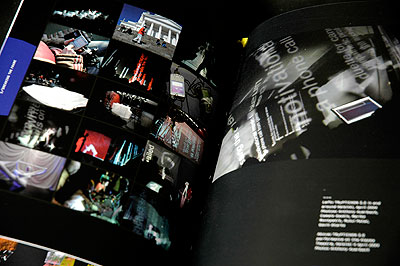
There’s a report from Kuwait during Ramadan 2002, a description of using cutting-edge wearable PCs, a discussion of the role of television, information about the harp in mythology, cyborg markets, the UK Data Protection Act, climate change, anti-gentrification, art and systems theory, UAVs, the Pacific plastic dead zone, and much, much more. There are projects that create free networks, dangerous musical instruments, taped-out surveillance camera boundaries, video installations, photographic images, movies of CCTV footage gained through freedom of information requests, manifestos, snowglobes, and cocktails.
(It’s a fascinating pleasure to read but it’s overwhelming to try and review.)
The portrait of Ambient.tv that emerges from all this is of intensive cultural critique pursued through a playful low-fi digital aesthetic. This isn’t a contradiction, the latter is in the service of the former. Ambient.tv’s projects and proposals tackle serious social and political issues. They do so through skilled use of the aesthetics and attitude of low-fi new media art and technological activism.
The wealth of ideas contained in the essays and other writing in the book show how historical, political and philosophical knowledge grounds the resulting art and indicates how it embodies a critique of contemporary culture.
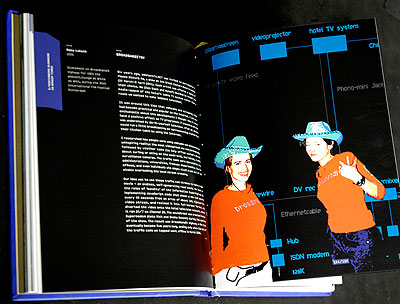
Contemporary culture as seen by Ambient.tv is surveillance culture, the database state with its DNA databases and laws that protect freedom by removing freedom. Ambient.tv is a realistic project, depicting the hidden forms of contemporary society that intrude into our lives. This is heavy stuff, and to air it critically without alienating the audience it requires precisely the playful touch that ambient.tv often bring to their art.
To take the example of FACELESS, 2007, (the first project I personally saw Luksch present), there is an exquisite balance between the disturbing idea of pervasive surveillance, the practical limitations of Freedom Of Information requests, and the visual and science-fictional narrative aesthetic that emerged from this. On their web site it states that it was produced “…under the rules of the Manifesto for CCTV Filmmakers. The manifesto states, amongst other things, that additional cameras are not permitted at filming locations, as the omnipresent existing video surveillance (CCTV) is already in operation.” The result is something more interesting and disturbing to watch than a simple collage of CCTV footage would be. The fact that the work can be made like this, that it can look like this, means something.
This strategy can be seen in “Mapping CCTV around Whitehall”, 2008, as well, which I also reviewed for Furtherfield here, and in many other pieces by Ambient TV.
Reading the proposals and essays shows the depth I suspected to this work, when I first saw it projected in a darkened room is there in its conception and execution.
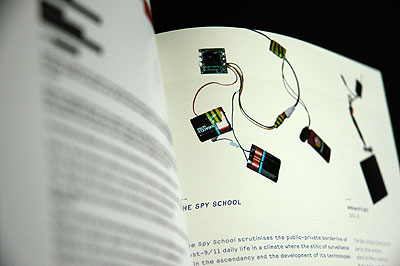
It’s an intense and inspiring experience to be faced with the textual equivalent of a decade-long open studio. The first essay in the book, a theory-laden piece by Fahim Amir, is almost overwhelming in a different way. It’s pure Theory, which will hopefully sell Ambient.tv to the artworld sectors that thrive on that sort of thing, but it isn’t the best introduction for newcomers to the project’s very accessible art.
But what a rare pleasure to be given such a wealth of insight into art that so acutely depicts our times. “Ambient Information Systems” is an important resource for contemporary artists and critics, an insight into the ideas and development of a very successful new media art practice. The grungey, playful, important realism of Ambient.tv’s work deserves presentation in a context that shows just what has gone into the art and just what people can get out of it. This is it.
The text of this review is licenced under the Creative Commons BY-SA 3.0 Licence.
Marc Garrett: You are an artist who works solo and with others in various ways. A large body of your work consists of performances, interventions and sound recordings. I want to begin this interview by asking, why you decided to form ‘The NeoFuturist Collective‘, and what was the main mission or purpose behind such a collective?
Joseph Young: The NeoFuturist Collective was born as a convenient way to house a piece of work I was making called ReAwakening of a City. The idea had started as part of a practice-based PhD at SMARTlab UEL, but as soon I got funding for the project from the Arts Council, I realised I didn’t want to spend the next four years writing about it…
I invited a group of artists to join me in making a collaborative piece of work from a seemingly simple premise – the transformation of urban noise, inspired by futurist artist Luigi Russolo’s Art of Noises manifesto. Russolo had created a series of “noise networks” or symphonies for his mechanical intonarumori (noise makers) back in 1914, and in so doing he had influenced the entire course of 20th century music.
Despite his contemporary resonance, little is generally known about Russolo’s work, as all of his instruments were destroyed in the intervening two world wars. Of the scores he wrote, only the first 7 bars remain of Awakening of a City, and that only because it was reprinted in the art magazine Lacerba. Apart from the fragment of written score there are letters, reviews, photographs and other forms of documentation which have led researchers and artists over the years to try and recreate his noise making instruments.
Our project is rather different – we use the remaining 7 bars as the starting point for a new piece of work, ReAwakening of a City, engaging with all forms of visual and aural urban noise that we spend so much time trying to block out. Traffic noise, junk emails, health and safety warnings, advertising and street furniture. The form is performative, visual and mediated as well as musical, using all available means at the disposal of the 21st century artist.
By engaging with my artist-collaborators’ practices, I commission work that responds to this central idea and then set up an appropriate curatorial context for extending that individual response into a collective noise network.
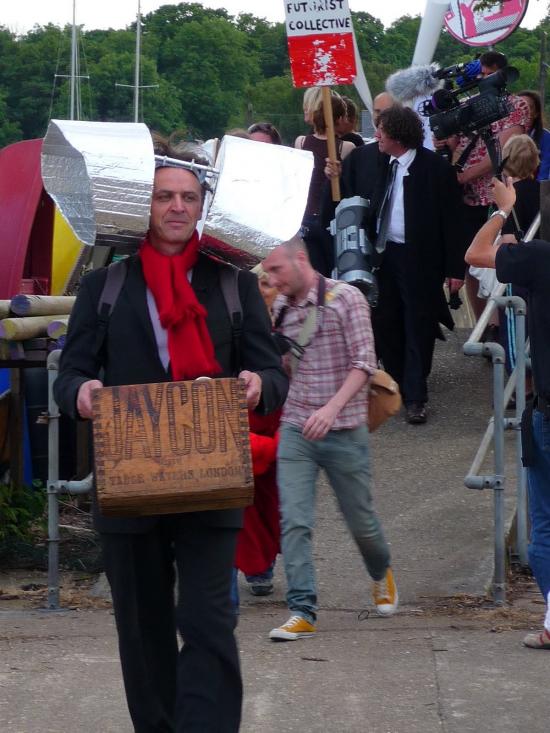
MG: Where did these ReAwakening of a City events happen, and what kind of response did you receive when these performance, interventions took place? How important was it to connect with others – every day people, whilst engaging in the process of expressing these real-life experiments?
JY: The first ReAwakening took place in Brighton in Feb 2008. We started off the project by declaiming the NeoFuturist manifesto (written by Rowena Easton) in Jubilee Square, with a bunch of workmen and their drills providing a fabulously appropriate accompaniment to the text which celebrates Urban NOISE. (The manifesto can be downloaded from www.neofuturist.org). The crowd then followed us onto the Arts Council offices where we laid a wreath on their steps in support of all the companies that had been recently cut – we were ourselves in receipt of Arts Council funding at the time. A classic case of biting the hand that feeds you. Our activities provoked mild amusement and little controversy however, as the good citizens of Brighton & Hove are used to seeing “crazy” artists peddle their wares in public.
A couple of months later we had our first performances of work-in-progress at The Basement, Brighton. The reaction here was far more hostile and interesting, with some audience members questioning our politics in the Q&A session afterwards, accusing us of proto- fascism. Actually the level of debate was thrilling, as we really touched people’s buttons and ended in a deep discussion about the impact of the Futurists and their relevance to the current political climate. This question surfaced again a few of months later in an online interview with The Thing Is… magazine.
We were fortunate after that to be invited to make a piece of work on Wall Street in New York for the psychogeographic festival, Conflux. Our proposal was to make a walking performance that explored the everyday experience of living and working in the Wall Street district and how this might inform our understanding of the impact that this small area of real estate has on the rest of the planet. We arrived on September 11th 2008 to be met by 9/11 conspiracy theorists on street corners, and proceeded to spend several days mapping the area through sound recordings, text and video in preparation for a dawn performance on 14th September – a ReAwakening as the city awakes. The effect was dramatic and unexpected, as my declaration of the NeoFuturist manifesto outside 1 Wall Street brought about the collapse of Lehmann Brothers that weekend and the subsequent domino effect on the global economic system. Sorry world!
Our next major intervention was more low key, but no less dramatic as we were commissioned by Fuse Medway festival to engage with and inspire the village community of Upnor. Our mission was to get the people to take to the streets in a protest/celebration march. We worked with the community over a number of months, holding public workshops and meetings, networking furiously in the local pub (one of four!) and it soon became clear that the general apathy towards the arts, and outsiders in general, meant that if the public were not going to come to us, then we would have to go to them. So we took to the streets and made work in public which enraged some, who questioned where our funding had come from, but delighted others and built a momentum towards our final performance.
A Call to Arms (as the piece was finally called) took place in June last year and was a very successful example, I think, of how one can make “community art” challenging as well as accessible. See http://neofuturist.blogspot.com for full documentation and a film of the performance.
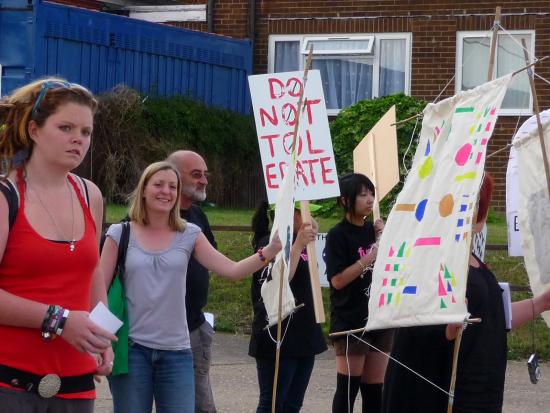
Other pieces of work, include shouting at the Futurist paintings with a megaphone, as part of the Tate Modern Futurist retrospective last summer. An experience as liberating as it was faithful to the original spirit of futurism, causing equal anger and delight amongst an unsuspecting public. I was also invited as a panellist to take part in a public debate along with other luminaries from the art world, on the subject of “Is the Avant Garde Passe?” organised by The Institute of Ideas in London. Here the public paid to witness a lively and informed panel discussion around the relevance of contemporary art, proving, it seems to me, that there is a real appetite for intelligent, politically driven commentary and debate.
A group of artists drawn from the fields of visual, performance, video and sound art will attempt to transform the everyday language of urban sounds and visual junk (such as spam emails and billboard advertising) into a true multi-media experience to do just that; asking us to question our assumptions about what is beautiful in a modern world of information overload.
MG: Your comments that contemporary art is in need of intelligent, politically driven commentary and debate rings true. In respect of my own art context(s). Thinking of the many amazing self-organised, networked communities, of which there are many, on-line and in physical space; there has been a massive shift of art creating, moving independently, yet in parallel to the ‘official’ and hegemonic examples accepted or considered contemporary at the moment. Of course, if we think about what contemporary means itself, it means existing, occurring, or living at the same time. The relationship between institutions and art which is actively critical and more challenging than easier processed art such as Brit Art, how they represent contemporary art.
Considering the history and knowledge we have regarding the original Futurist movement, and its close connections with fascism. For instance, what is less known is that, the Futurist movement did not only consist of fascists, but within it there were also socialists, anarchists, leftist and anti-Fascist supporters. Consisting of interesting individuals such as Georges Sorel, who explored his own views and intellectual thinking, right across the political spectrum. Georges Sorel “…was a voluntarist Marxism: he rejected those Marxists who believed in inevitable and evolutionary change, emphasising instead the importance of will and preferring direct action. These approaches included general strikes, boycotts, and constant disruption of capitalism with the goal being to achieve worker control over the means of production.” http://en.wikipedia.org/wiki/Georges_Sorel
I can see a direct link from Sorel’s activist approach and The NeoFuturist Collective’s ReAwakening events and performances. Of course, there are some other pretty good contemporary art activists out there at the moment, who also incorporate performance as part of their creative process; such as ‘The Office of Community Sousveillance’. “This work rests between legality and illegality. By posing as security officers, ‘PCSO Watch’ imaginatively play at the borders of what is typically deemed right and wrong, real and unreal, pushing their expression in the form of political enactments and direct action. This is a paradigm shift, not particularly interested in the art critic’s perspective.” http://www.furtherfield.org/displayreview.php?review_id=338
“Futurism has produced several reactions, including the literary genre of cyberpunk — in which technology was often treated with a critical eye — whilst artists who came to prominence during the first flush of the Internet, such as Stelarc and Mariko Mori, produce work which comments on futurist ideals.” The legacy of Futurism. http://en.wikipedia.org/wiki/Futurism#The_legacy_of_Futurism
With the understanding that there have been various influences, mutations and re-appropriations from the Fururist movement, I am wondering what elements you feel or think are still important to reclaim, reshape and reintroduce into a contemporary world, both in respect of the art arena and in relation to our everyday environments?
JY: What interests me in relation to the Milan Futurists is, first of all, the misperception, as you have pointed out, that futurism was primarily a fascist movement. My understanding is that Marinetti was the only artist to have that association, having been invited to serve on the Central Fascist Party Council after the First World War. He resigned not long after as soon as the Catholic Church was also invited to sit on the Council – Marinetti being an avowed atheist. This is not to excuse the entire movement of this problematic association, but it does put it in context. It also recognises that a spirit of optimism and a belief in technological solutions to the world’s problems, that futurism embodied, also has its’ darker side. And it is with this knowledge that I choose to engage with (neo)futurist ideas in the 21st century, as it seems to me, that in a world seemingly on the verge of collapse, that a spirit of positivity renewal is both urgent and necessary, and also the ultimate political gesture.
You mention various artist collectives that have appropriated the futurist legacy in this way, and to that I would add Ultra-Red who, incidentally, published a short sound piece of mine, recorded on Wall Street during the crash of 2008, as part of Fifteen Sounds of the War on the Poor vol.3.
In order to engage with the state of the planet, artists can no longer cling to romantic, utopian notions of nature/beauty in opposition to man/technology. This dichotomy seems to represent more about human self-loathing than it does about a workable solution to global warming/terrorism/the energy crisis/reform of global capitalism, etc. Moreover it leads us towards a new “medievalism” (ban air travel, ban cars, buy local) that is all too prevalent in ecological pressure groups. In this argument, man has brought us to the edge of destruction, therefore we must drastically scale back all of our wealth-producing activities. As if the (post)modern world could be wished away in either Luddite vision of the future or more worryingly in the ideology of The Zeitgeist Movement, whose apocalyptic vision of a radical eco-future involves tearing down our cities and rebuilding them.
This thinking is also represented in the work of acoustic ecologist and renowned nature recordist, Bernie Krause in his article, Anatomy of the Soundscape: New Perspectives, Journal of the Audio Engineering Society, Jan/Feb 2008 Vol. 56 Number 1/2, Pg 73-80 (2008), in which he dissects the soundscape (a term first coined by R Murray Schafer in Soundscape: The Tuning of the World) into 3 separate strata:
“GEOPHONY is framed as natural sounds emanating from non-biological sources in a given habitat.acoustic variations. BIOPHONY By far the most complex and laden with information, this unique feature of the soundscape is comprised of all of the biological sources of sound from microscopic to megafauna that transpire over time within a particular territory. ANTHROPHONY, defined as all of the human-generated sounds that occur in a given environment: physiological (talking, grunting, body sounds), electromechanical, controlled sound (music, theatre, etc.), and inci- dental (walking, clothes rustling, etc.).”
In this breathtaking philosophical leap, Krause removes the human from the natural environment and pits him/her in opposition to it. In creating a separate category for human sound activities outside of the biophony (i.e. the sounds of all other species on the planet), he is both over-stating human control and dominance over the environment and also denying us a role in the Gaia hypothesis – one of the green movement’s central texts, that views the Earth (and all of its inhabitants) as a single organism.
I am certainly not refuting or seeking to contradict many of the arguments regarding human sound activities and stress levels, posited by the World Soundscape Project, of which Krause is a prominent member, but it is worrying that so many eco-activists see humanity as a problem and not as a solution. And this is where Futurism and its antecedents/mutations can offer a way forward…
If, as I believe, we can find beauty within the drone (our drone), then the clamour of urban noise, both visual and aural, can be transformed in our perceptions into something of interest and value, rather a thing to be blocked out or ignored. If we can stand in a busy place such as Oxford Circus in the centre of London and open our ears to the sonic detail that is contained within the omnipresent drone of human activity, then we can begin to understand that activity as a creative as well as a destructive force. We can then harness and use this energy to power and revitalise the human spirit.
So, for me, the Art of Noises manifesto is the central and critical text in beginning to shape a new understanding of the contemporary sound and land-scape. If we can find a way of reframing urban noise as a meditative experience, as I recently did in my residency with Blast Theory, then we are part of the way to ReAwakening our cities as places of hope and optimism. To do this, I made a number of immersive binaural recordings of the area around 20 Wellington Road, where Blast Theory are based on the industrial outskirts of Brighton, and mediated these as iPod listening experiences in a temporary installation space that I set up for the event. When I came to retrieve participants from the room (they went in 4 at a time) they had invariably made themselves comfortable and been totally immersed in the sounds of the local traffic. They often described their experiences as “relaxing” and “enjoyable”, and how many times can you say that of the experience of standing beside a busy, urban, traffic-filled road?
So that is my mission for ReAwakening of a City; to take Russolo’s lead from the surviving 7 bars of his score to Awakening of a City (1914) and reframe and rework the paradigm of the celebration of urban noise to (re)awaken of all of the senses through a heightened perceptual shift in one of them – that of hearing; the neglected sensory cousin in our predominately visual culture. My ultimate ambition being to create a large-scale performance event for the 100th anniversary celebrations in 2014, in collaboration with like-minded artists from around the globe.
This article is co-published by Furtherfield and The Hyperliterature Exchange.
Millie Niss, the writer and new media artist, died of swine flu with complications at 5 a.m. on 29th November 2009. Her mother and longtime collaborator, Martha Deed, was with her then. She had been in hospital for four weeks, mostly in intensive care, after picking up the virus, which quickly became serious in her case, probably because she already had respiratory difficulties due to a rare condition known as Behcet’s Disease. She was 36 years old.
The news would have been sad to hear about anyone, but it was especially sad in Millie’s case because she was one of the people in the new media community with whom I felt particularly close. I met her at the trAce “Incubation” conference in Nottingham in 2004. When I first arrived at the conference, I was directed to the part of the room where Michael Szpakowski was because he and I had already struck up an e-mail friendship, and he’d left a message for me at the door. I found him talking to Millie. Michael was only there for that first evening because he had to go and see his father, but Millie was there for the rest of the conference, and I sat next to her at many events. She was dark-haired, overweight and funny: very easy to talk to. Later in the conference, she gave a presentation about how to attach behaviours to objects in Flash, which I attended along with Jim Andrews and others. She kept saying beforehand that she was feeling pretty nervous about it, but she seemed very natural and nerveless when it came to the event. In the beginning, she asked for suggestions from the audience – I think for an initial idea on which to base her Flash piece – and at first, nobody said anything. She suddenly became acerbic – “Oh come on – don’t make me pick on someone like you were a bunch of school kids!” Immediately you could see her as a teacher and imagine how she would have controlled a classroom. I suggested spiders, which set the ball rolling, and from that point onwards, everything went very rapidly. She quickly and expertly demonstrated how to set up a drawing of a spider as a symbol, and attach a behaviour to it so that when the mouse pointed to it, a sound file played. Another thing I remember was that she was very critical of certain aspects of Flash – how you had to import things into your library and then drag them from the library to the stage before you could do anything with them. You could feel her personality’s force, her opinions’ sharpness, and her sense of humour and fun.
From that time onwards, she and I regularly exchanged e-mails. She knew that I worked in the National Health Service, and because she was very much in the mill of health care herself, we had some lengthy correspondence about how the UK system worked, compared with how things worked in the USA. She also sent me two glass unicorns through the post – occasionally, she would run little competitions on her “Sporkworld” website and offer glass unicorns to participants as prizes. The first of these unicorns went to my daughter Rachel, and the second is still sitting on my study window-ledge in a white cardboard box. He used to stand out on his own four feet, but unfortunately, he had an accident with the curtain, and one of his legs got knocked off. I stuck it back on with Superglue, but it fell off again. Millie knew all about this, and I sent her a photograph of the unicorn on my window-ledge – I think I even sent her a second photograph, showing how he looked after his accident and temporary repair. She was always very interested in Rachel and liked to hear my stories about her. Perhaps they reminded her of her childhood, or perhaps she just liked kids.
One thing which came across from Millie’s correspondence, as well as from her work and her occasional online commentaries, was her sense of perspective on new media art. She was grateful to it because it provided an outlet for her creativity which she had never managed to find through traditional print; but all the same, she remained aware that it was a small and specialised field and that a good deal of new media work might seem incomprehensible to “ordinary” people. Her comments about other new media artists reflected this grounded attitude. She preferred work which didn’t reach for the hi-tech solution that a lo-tech one would do – work, in other words, which didn’t employ technology for its own sake, and where the form was dictated by content rather than the other way round. Likewise, she wasn’t particularly bothered whether her output complied with the dictates of new media theory – whether it was interactive, non-linear, coded or networked. The pieces on her website exhibit a cheerful mixture of genres and media: Flash, video, poetry, prose, photography, sound files and plain old HTML rub shoulders in much the same way that political commentary, literary criticism, observations of places and people, food appreciation, nature notes, raucous humour and occasional obscenity rub shoulders in her blog. The groundedness of her art, and her sense of responsibility towards her audience, is demonstrated by the way in which she habitually presented videos on her site in different sizes and resolutions – for example, “Warhol’s Campbell’s Brodo” is available 8.85mb, 6.23 MB and 2.43 MB – so that people with slower connections could sacrifice a bit of quality to save a long wait if they so desired. Similarly, her introduction to “Warhol’s Campbell’s Brodo” explains that “brodo is the Italian word for soup and the restaurant’s name”. Without talking down to her audience or limiting what she wanted to say, she was always at pains to be as clear and user-friendly as she could – and this insistence on clarity and user-friendliness, her desire to reach out to an audience of “ordinary” people whenever possible, was one of the things which made her voice such a distinctive and refreshing one in the new media world.
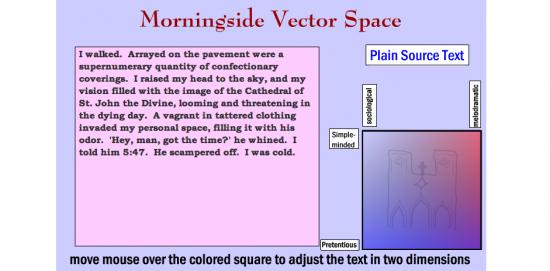
However, this is not to say that she was any Luddite or uninterested in the theory of any description. One of her best-known pieces of work – a collection of six pieces – is the Oulipoems, reproduced in Volume One of the Electronic Literature Collection in 2006. As Millie explains in her introduction, “Oulipoems is a series of six interactive poetry Flash works… loosely based on the Oulipo movement in French literature, which focused on texts based on constraints… and also on mixtures of literature and mathematics.” One of the Oulipoems is “Morningside Vector Space”, which rewrites a description of a simple incident in various ways, depending on how we move the mouse cursor over a coloured square. The source text reads:
Yesterday, I was walking on Amsterdam Avenue. There were cracks in the sidewalk. I looked up and saw the tall and unfinished Cathedral of St. John the Divine. A man approached me. ‘Excuse me, do you have the time,’ he said. I told him at 5:47. He walked (sic) away. It was windy. The coloured square is marked to indicate the inflexions this text will be given if we hover over different areas – from “Simple-minded” to “Pretentious” on the x-axis and from “Sociological” to “Melodramatic” on the y-axis. If we point to the “Simple-minded” corner, we get this:
I walked. On the sidewalk. By the big church. There was a man. He wanted the time. I gave him my watch. He left. I was cold.
The intersection of “Pretentious” with “Melodramatic” yields this:
A vagrant in tattered clothing invaded my personal space, filling it with his odor. ‘Hey, man, got the time?’ he whined…
The intersection of “Pretentious” with “Sociological” produces:
The sidewalk, unmaintained by the municipality, contained evidence of substance abuse…
– and so forth.
A number of observations come to mind about this piece. First of all, although it isn’t tremendously technically sophisticated, it does reveal a very competent grasp of Flash and object-oriented coding. This grasp is also displayed in many of Millie’s other pieces. Secondly, it demonstrates the “mixture of literature and mathematics” to which Millie refers in her Introduction to the Oulipoems – the idea that different styles of writing can be mapped onto a graph and summoned by pointing at different vectors – and in doing so, it demonstrates a willingness to experiment with text, and an openness to the idea that text in digital literature may sometimes be manipulable by the audience, rather than fixed into a single unquestionable form by the author. Thirdly, “Morningside Vector Space” is funny and accessible. The labels with which Millie marks out her vectored space are humorous, and the texts with which she illustrates these different writing styles are exaggerated for comic effect. At the same time, there is an undercurrent of social observation, with a suggestion of political edge: “I was observing a mixed-income neighborhood on the borders of a low socioeconomic enclave… Lacking funds for a watch, he had to rely on others in the community to be on time for his appointment with the social services…”
Lastly, perhaps least obvious is a powerful sense of place. The piece’s title refers to Morningside Heights, an area of Manhattan in New York. The texts allude to Amsterdam Avenue, a street in Morningside, and the Cathedral of St John the Divine, which stands there. St John the Divine is also known as St John the Unfinished because although it was begun in 1892, it remains incomplete to this day – hence the description of the cathedral as “tall and unfinished”. The coloured vector space in Millie’s piece contains another reference to the cathedral, in the shape of a wobbly but recognisable line drawing of its facade. This sense of place is an important aspect of Millie’s output – not only in videos about places such as “Jewel of the Erie Canal” or “A Hecatomb in Cheektowaga” but also in new media works such as “The Talking Escalator at Penn Station”and “Unscenic Postcards” – and like her interest in politics, it demonstrates her commitment to the “real” world, as well as her talent for observation and comment.
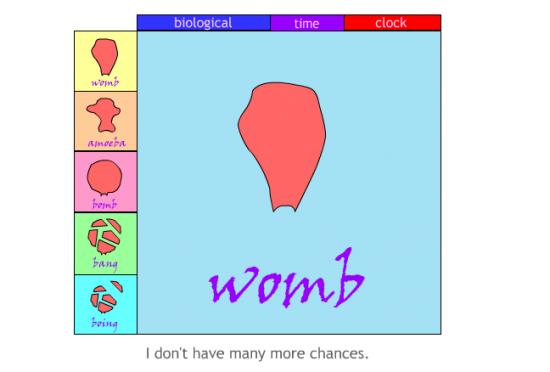
Another of Millie’s Flash pieces, and one of her most personal artworks, is “Biological Time Clock”. In a central pane, the words “womb”, “amoeba”, “bomb”, “bang”, and “boing” appear, accompanied firstly by Millie’s voice intoning the same words, and secondly by drawings of a womb, an amoeba, a womb inflated to the point of bursting, a womb breaking into pieces, and another slightly different drawing of a womb in bits. Underneath this pane appears a randomised sequence of phrases, arguing both for and against getting pregnant and giving birth: “It’s not for me”, “I’d be nurturing”, “I’m more than a womb”, “I’m not together enough”, “maybe I should do it while I can”, and so forth. There are also buttons that allow you to add extra sound effects, such as Millie saying “tick-tock” or chanting “biological”.
There are feminist aspects to the piece – one of the anti-pregnancy phrases is “I don’t want to be a breeding cow”, and another is “I’m more than a womb” – mixed with what seem to be more autobiographical notes, such as “why am I alone?” and “I don’t want to lose my creativity”. However, a question that seems to go to the heart of the piece is what is the word “boing” doing in there? The drawing which accompanies this word is enigmatic. Still, it may be meant to suggest that the womb, which broke apart at “bomb”, is now somehow bouncing back together again – and by implication, that no matter how many times the author talks herself out of childbirth, her consciousness of her womb keeps coming back to bother her afresh. But the word “boing” serves another purpose by introducing into the piece the quirky, unpretentious, comical note essential to Millie’s art. If the word sequence at the heart of the poem were simply “womb, amoeba, bomb, bang,” then both the message and the tone would seem much starker. With “boing” on board, there is a playful and funny element to the piece, a release from serious description into exaggeration, which seems to suggest that Millie herself isn’t taking it completely seriously, and we don’t have to take it completely seriously either.
In some ways, this insistence on the quirky and the wacky might be considered a weakness or a limitation in Millie’s art, flinching away from completely direct and honest engagement with her subject matter, symptomatic of a tendency to let both herself and her audience off the hook, especially if her subject-matter happens to be personal. But it should be borne in mind that Millie had more personal subject matter to deal with than most of us, and her insistence on humour was an essential part of her strategy for dealing with it. One of the anti-pregnancy arguments on “Biological Time Clock” is “I’m not well…” and it is impossible to write about Millie’s art without taking her mental and physical ill health into account, if only because so much of her art deals with it. For many years she was considered – and considered herself – to be mentally ill with Bipolar Disorder. Millie’s experiences of mental illness and the health and social care professionals with whom it brought her in contact are memorialised in “The Adventures of Spork, the Schizophrenic Skua”. As described on Millie’s site:
Millie Niss created Spork… to be a sympathetic and intelligent character who was also an indigent client of the mental health system. The cartoons began to express frustrations about how mentally ill people and welfare recipients are treated, but later on, other issues and pure silliness were added to the Spork series.
Eventually, after years of treatment for mental illness, Millie was diagnosed with Behcet’s disease, a severe disorder of the immune system which can cause depression along with ulcers, skin lesions, stomach problems and inflammation of the lungs. Before this diagnosis, however, she suffered attacks of dangerously acute depression, and one part of her website is devoted to suicide (http://www.sporkworld.org/suicide). The way in which she tackles this subject makes it clear how her sense of humour, far from demonstrating an unwillingness to confront her inner demons, was really evidence of her mental toughness and self-discipline in dealing with them – a refusal to give in to self-pity:
I was often, very often ready to kill myself, but I hate guns and wouldn’t want to use one. And lying on a gun license application was out of the question: I would not sign my name to a paper which said I was not intending to kill myself or was not mentally ill… Hanging was reputed to be painless and so we thought getting sentenced to death was the perfect out: that way you could have the benefit of dying without the guilt of doing it to yourself. It was unfortunate that you had to do something awful to get sentenced to death, though… A big question was the suicide note. Should you leave one or not, and if so what should you say in it? The argument for not leaving a note was a strong one: someone might find the note and stop you from doing it… The desire to write a suicide note that was a literary masterpiece kept me alive at times. I couldn’t kill myself until I thought of something good enough.
In these passages, Millie combines a sharp, satirical, almost gleeful insight into the ironies and self-contradictions of the suicidal mindset with an understated – but nevertheless essential and genuinely tough – conviction of her individuality and status as an artist. As she insists in “Biological Time Clock”: “I have a brain”, “I’m more than a womb”, and “I don’t want to lose my creativity”. In “Suicide”, the idea that she doesn’t want to kill herself until she can devise a sufficiently well-written suicide note is a good joke at her own expense. Still, it also points to something deeper: her writing is her way of dealing with depression and her reason for not succumbing. It gives her a sense of self-worth, and the discipline of art allows her to detach herself from her feelings and sublimate them, thereby gaining some form of control over them.
In an article entitled “Suicide, Art, and Humor”, which she published on Michael Szpakowski’s website “, Some Dancers and Musicians”, Millie wrote that “The artist has a duty, some might say, to produce art. But with that comes the more fundamental duty to stay alive.” This is a typically grounded remark: the artist’s duty to life is “more fundamental” than her duty to art. Referring to her own “Suicide” piece, she goes on: “I was at least trying to be funny… Art is a force that tends towards life… While you are writing a despairing poem, you are, in the act of writing, temporarily suspended from the act of despairing.” The effort to be funny and thereby entertain an audience, art as an affirmation of life, and art/humour as a defence against despair – all of these ideas were essential to Millie’s work.
The same values are apparent on the Sporkworld Microblog, which Millie shared with her mother, Martha Deed. They are present even in the very last days of her final illness. Here is an entry from 16th November: “We like to keep a chipper tone here, and we do not intend this to be a place to list complaints. We also insist that any personal events must be… transformed from raw anecdote into something with literary intent.” Martha actually wrote this, but Millie approved it, and it reflects a shared philosophy that runs right through the site’s contents. “Raw anecdote” is inadmissible, not only because it may lack the “chipper tone” that the Microblog seeks to maintain, but because it also lacks the discipline and detachment of real art. The word “raw” suggests something of the harshness of unfiltered experience. The artist’s job is not to pass on this harshness to the audience direct and unmediated, but to control it through an effort of will, to fit it into a composition, to comment on it, reason about it, make jokes about it and turn it into an element in discourse; and thus to humanise it.
After Millie’s death, Martha published a poem on the Microblog entitled “Travelling with H1N1”, which contains the following lines:
even if it is difficult to be funny
while intubated, you will fight and fight and fight…
you will be sending email on your way to the fluoroscope
with subject lines like
I never thought I would write email while intubated”…
The sense of humour, the refusal to give in, and the determination to fight back against her difficulties by finding something to say about them were all there until the very end. Martha relates that in the intensive care Unit (ICU), although she couldn’t speak because she was on a ventilator, she kept her lines of communication open by writing things down. She struck up a friendship with a nurse supervisor, Tom, who “was astonished at her ability to tolerate the ventilator and keep up a running conversation in her notebooks… He continued to visit her in the ICU and received her candid evaluations of her care there – both good and bad – and he found her to be very funny and brave.”
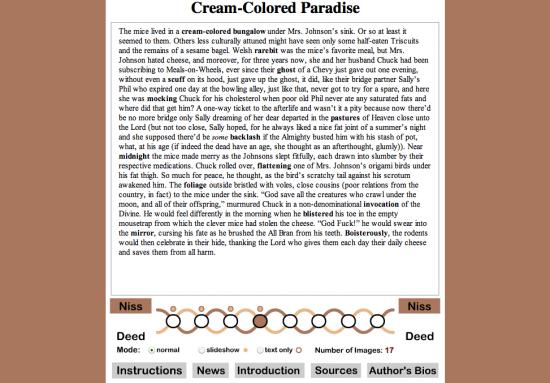
Mentioning the Sporkworld Microblog, and the fact that it was shared with Martha Deed, brings us to Millie’s frequent and long-term collaborations with her mother. Millie is known as “Spork Major” on the Microblog, while Martha is “Spork Minor”. Apart from the blog, they collaborated on many other works – Martha co-wrote the “Oulipoems” texts, for example, and “Jewel of the Erie Canal” is credited to them both. But one of the largest, most ambitious and most formally developed of their collaborations is News from Erewhon, a series of parallel surreal fictions created by the process of “guided free association”.
News from Erewhon is by no means a perfect work of art. Firstly, the title makes a rather distracting reference to Samuel Butler’s satirical, pseudo-Utopian novel “Erewhon”, which doesn’t really seem to have much to do with the rest of the book. Secondly, each chapter is accompanied by a number of images which zoom up in front of the words and then quickly fade away to allow us to read on. The Introduction argues that these add “another level” to work and that the pictures “appear only briefly to affect the viewer in an almost subliminal manner”. In fact, their main effect is to make you lose your place. Luckily, Millie provides a button which allows us to switch the images off.
Nevertheless, the texts themselves are fascinating. They were written in an almost Oulipo-like manner. Several words were picked randomly from chosen books; then, using these words as “seeds” and incorporating them into their writing as they went along, both Millie and Martha produced a series of eight “miniature fictions, situated halfway between poetry and prose”. As the Introduction says, these fictions suggest “a bizarre alternate universe, whose characters and settings evoke themes such as war and peace, the workplace, and religion. These themes… weave in and out of the texts like strands in a braid. The two authors can also be seen as separate, interacting strands.” The image of strands in a braid suggests both the closeness with which Martha and Millie were able to work together and the fact that they always retained their distinct identities and styles, and News from Erewhon is a good demonstration of this. Millie’s sections are generally longer than Martha’s and more narrative in style, whereas Martha’s tend to be more surreal and poetic. Both, however, display a constant flow of inventive wit. One of the funniest of the lot is Millie’s fourth:
The mice lived in a cream-colored bungalow under Mrs Johnson’s sink. Or so at least it seemed to them. Others less culturally attuned might have seen only some half-eaten Triscuits and the remains of a sesame bagel… “God save all the creatures who crawl under the moon, and all of their offspring,” murmured Chuck in a non-denominational invocation of the Divine. He would feel differently in the morning when he blistered his toe in the empty mousetrap from which the clever mice had stolen the cheese. “God Fuck!” he would swear into the mirror, cursing his fate as he brushed the All Bran from his teeth.
Seed-words for the passage are shown in bold. Here is an extract from Martha’s equivalent passage:
A cream-colored bungalow? How could you? It will curdle in the sun, and this is July, she said… Your invocation of natural disasters has blistered the mirror of my mind, he moaned.
Both writers, it will be noted, start by cheating: instead of introducing the “cream-colored bungalow” into their stories in a literal-minded way, they bring it in obliquely. Martha imagines a bungalow, not the colour of cream, but actually painted with cream on the outside – hence the objection that “it will curdle in the sun” – while in Millie’s story, the bungalow only exists at all in the collective imagination of a family of mice. Martha sticks more closely to an underlying structure suggested by the seed words, producing a more densely written text and poetic texture. This is particularly evident in the alliteration – “colored”, “could”, and “curdle” or “mirror”, “mind”, and “moaned”; but also in the lilting rhythm – “Your invocation of natural disasters has blistered the mirror of my mind, he moaned”. Millie, on the other hand, shows something of the novelist’s delight in incidental detail – “Triscuits”, “sesame bagel”, “under Mrs Johnson’s sink”, and “he brushed the All Bran from his teeth”. Her passage seems to take a serious turn with the phrase “God save all the creatures who crawl under the moon” – simultaneously poetic, literary and religious – yet this moment of gravity is almost immediately reversed by an explosion of comical blasphemy – “God Fuck!”
It would be too simplistic to suggest that Martha was always the more focused and disciplined partner in collaborative work. It should be remembered that Millie was the techno-savvy one, and therefore the design and construction of the Sporkworld site, the Microblog and News from Erewhon were all carried out by her. Her work in this area is always individualistic rather than textbook. Still, at the same time, it exhibits both a powerful emphasis on user-friendly functionality and a considerable visual flair. She may have presented herself as the mercurial, comical, slightly wacky half of the partnership, but there was always a sharpness, toughness, self-discipline and a determination to succeed just under the surface.
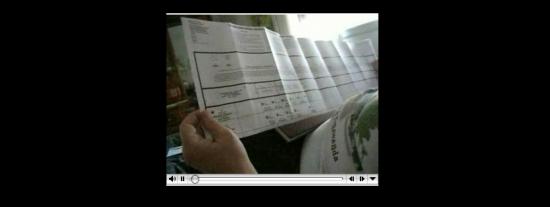
On the other hand, Millie’s work undoubtedly has an impulsive element, and in the collaborations, this makes a compelling contrast with Martha’s more studied approach. “God Fuck!” is one example; another is “Voting”, a video made in November 2008 showing Millie’s difficulties, as a disabled individual, in trying to deal with her postal vote form. Her ballot paper combines a list of presidential, senatorial, and Congress options and several constitutional issues specific to North Tonawanda, the town in which Millie and Martha live. As a result, it’s a huge sheet about the size of a tablecloth, with as many creases as an Ordnance Survey map, and just as difficult to flatten or re-fold. Step by step, Martha takes Millie through the different options on offer, with Millie keeping up a gunfire of questions and acerbic commentary, interspersed by short periods of silence during which she gasps for breath. Both Martha and Millie are represented on-screen mainly by their hands – first Martha’s, as she manipulates the ballot paper and fills it out in accordance with Millie’s instructions; then Millie’s, towards the end of the process, as she signs the outside of the envelope to authorise her vote. Apart from this, they are represented by their voices: Martha’s calm and methodical, Millie’s staccato and satirical, but both become increasingly impatient as the difficulties of dealing with the ballot paper become increasingly apparent. Ultimately, Martha can’t get it folded to fit the official envelope. Then Millie has to rehearse her signature because her hands are so afflicted with arthritis that she struggles to hold a pen. Then the envelope is difficult to sign because it’s so fat and unshapely with the ballot paper inside it. Then it turns out that the envelope will have to be taken to the Post Office and weighed because it isn’t pre-franked or freepost; at which point –
MILLIE: Okay, so we’re gonna have to pay postage on top of this… and it has to be weighed because it’s so fucking heavy!
(Slightly shocked pause.)
MARTHA (elaborately self-restrained): Did you mean to put the word “effing” in?
MILLIE (immediately): I did! I absolutely did! I mean, it’s a matter of free speech. The Supreme Court would have upheld my right to say fucking on my own blog. There have been efforts to make it impossible to say that.
MARTHA (holding up the envelope, with a noticeable change of subject): Okay, I think we actually have it done.
It’s a wonderful piece of film-making. Whether or not you agree with what Millie seems to be hinting, that there is a deliberate attempt on the part of the establishment in the USA to discourage people at the margins of society from taking part in the democratic process, or whether you prefer the view that bureaucrats have no conception of the difficulties faced by the people on the receiving end of their bureaucracy; the point that the postal ballot, which is supposed to make it easier for disabled people to vote, actually makes it almost intolerably difficult, has been well and truly established by the end. But the real strength of the video lies partly in the interplay between the two main characters and partly in the underlying theme of Millie’s disability and how they handle it. As with Millie’s work, her illness is central to the meaning of the piece, yet it isn’t about the experience of being ill. It’s about how illness changes your relationship with the rest of society – one of her most powerful themes. But it’s also about coping with that situation through the help of others – in this case, Martha – and through a supreme effort of will.
Much of the poignancy of the piece lies in the soundtrack: Millie gasping for breath on the one hand and Millie rattling off her machine-gun-like commentary on the other. You can’t ignore how ill she is and doesn’t ignore it herself, but she won’t let it shut her up. The video is a gradual crescendo of comedic impatience, culminating in the obscenities at the end. Her outspokenness is a refusal to be silenced by society and the universe, which has trapped her spirit inside such an inappropriate body. She overcomes her difficulties by externalising them. She makes them the subject of her art, and by doing so, she finds her voice.
No doubt Millie would have become an artist of some description, whatever body, circumstances and state of health she was born into. She was sufficiently remarkable for that. But without her ill health, the work she left behind would have been very different: less spiky, poignant, funny and perhaps less urgent. Her output is not defined or limited by her health, but her health gave her her most important themes and powerful moments. The supreme irony of her art is that, like the knotty grain of a piece of burr elm, the things that made her imperfect were the same things that made her unique and beautiful.
©Edward Picot, December 2009
“Mapping CCTV around Whitehall”, 2008, is, as its name implies, a performance of mapping Closed Circuit Television (CCTV) security cameras around the UK’s parliament in London and a video record of that performance by Ambient.tv’s Manu Luksch.
Starting with a HAL 9000-like image of a CCTV lens, the video of “Mapping CCTV In Whitehall” has a glitchy techno aesthetic of sound and images with a post-MTV-Style Guide reportage feel. The first half consists of a recording of the police stop-and-search interviewing Luksch under anti-terrorism legislation, with a map of the area superimposed. The second half consists of CCTV views of the range of Camera number 40 being taped out, and of the people caught within those bounds. Words flash on the screen to identify the subjects of CCTV (….Artists! Sexy Arses!). This redeployment of the language of mass media visual persuasion opens up what we see rather than closing it down, making it a very effective encapsulation of the project’s ideas and aesthetics.
(One tiny criticism is that the video ends with a Creative Commons logo but doesn’t specify the licence. Artists, please at least give the licence URL, and do choose the copyleft BY-SA licence if you can…)
Wandering around to locate CCTV cameras may seem like a cosy techno-fetishist performance, a post-cyberpunk flaneur’s stroll around the streets of London with a pencil, an A-Z, and a tri-field meter. But the creeping authoritarianism of still-Thatcherite Britain makes it an act of protest against a specific law and a reversal of the assumptions of our seemingly unstoppable surveillance culture.
The Serious and Organized Crime and Police Act of 2005 criminalized political expression within an exclusion zone for a kilometre around Parliament Square. It is an indicator of the authoritarianism and assumption of privilege that has come to define political culture in the UK. It is too easy to become cynical in the face of such brazenly opportunistic ideology. If art can help to defamiliarise this in a playful and aesthetically rewarding way then it can help to undo that cynicism, and even more to go beyond it.
The assumption that the State needs to know where you are at all times, just in case you are a terrorist or a paedophile, but that you must not know the workings of the State, just in case you are a terrorist or a paedophile, is at odds with the idea of an open society. The area of London that Luksch has mapped is the SOCPA exclusion zone. A map of CCTV cameras is clearly useful to terrorists, and a map of the CCTV cameras near Parliament is clearly an act of dissent against the political consensus that constitutes domestic extremism. The police who interview Luksch touch on these ideas.
A political elite that is fearful both of and for its polity has retreated into managerial, authoritarian, paternalistic risk-management. That polity is conceived of, post-cold-war, not even economically, more nihilistically. This produces the very loss of freedom that it claims to protect against. The paradigm of government has become the watchful parent who is seen to be good by their watchful neighbours because they prevent their child ever straying into danger. But it is impossible to protect the population against all risk and this knowledge leads to impotent fearfulness. “Something must be done” and so security theatre, the spectacle of impossible systems and behaviours designed to reduce the perception of risk to zero, is used to reassure. Although whether the populace or the politicians are meant to be reassured it is hard to tell.
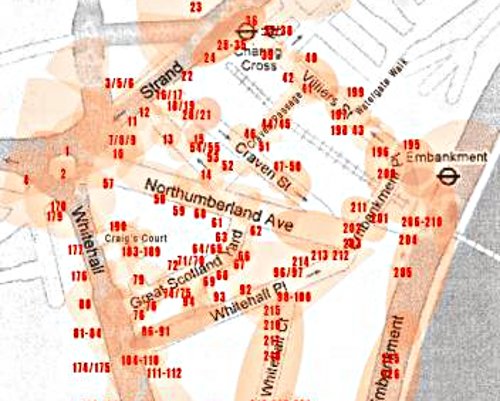
CCTV is part of that reassurance, of the spectacle of security theatre. The UK has the highest density of Closed Circuit Television Cameras (CCTV) in the world. The average Briton is (allegedly) captured on CCTV 300 times a day and there are more cameras in the supposedly open society of the UK than in notionally communist China. Not per head, in total. The area that “Mapping CCTV around Whitehall” focusses on is ground zero for this tendency.
CCTV doesn’t solve crime, it is used to spy on legal protest and it has been placed in school classrooms and pubs.
CCTV recordings are subject to the Data Protection Act, and from 2002-2008 Manu Luksch used personal data requests under the act to obtain the CCTV recordings of her going about her business that she used to make the film “Faceless”. The videos usually had other people’s faces blotted out to protect their privacy, which gave the resulting film its science fiction plot of people starting to lose their faces. But as Luksch was making “Faceless”, the responses to her personal data requests became rarer as the authorities adjusted the balance of power back in favour of themselves.
In 2008, Luksch returned to the subject of CCTV with “Mapping CCTV around Whitehall”, this time mapping out the CCTV cameras themselves within a particular area of London over two days. On the first day she located hundreds of CCTV cameras, on the second she measured the range of the wireless broadcasts of one of them. Part performance, part land art, this has a number of artistic precedents, from the 1960s conceptual artworks that consisted of magnetic fields or patterns of heat, to Situationists strategies for recontextualising the city by navigating it using the wrong map.
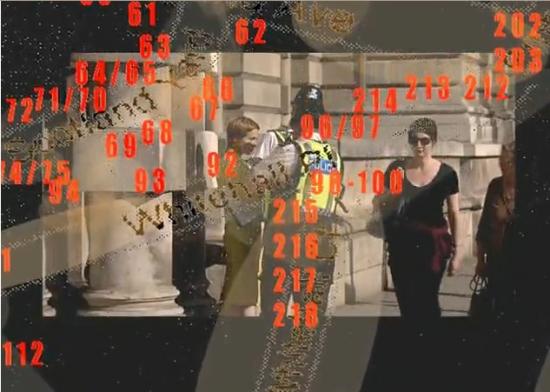
Mapping unseen electromagnetic forms was a strategy of some Conceptual Art, whether Art & Language’s landscape art infrared photograph of buried hotwires under a field or gallery-based magnetic and radio-proximity devices. Contemporary artists have used RFID tags Intangible form is irresistible for post-Duchampian attempts to keep the philosophy of art about aesthetics, and for conceptualism it is a way of keeping the artwork open. But the range of a CCTV camera is both definite and, if you have access to the camera, visual. The unseen form of the limits of its observation and the transmission of what it sees tie form to power quite directly.
In “Mapping CCTV around Whitehall” these forms and their composition are part of the landscape of the city. The city is obviously an artificial environment. In contrast, nothing might seem more natural than a painting of the landscape of the countryside. But landscape painting are depictions of valuable property for the landed gentry who commissioned them. They show and by showing make real the products of the ideology of the ruling class using aesthetics. They extend the domain of taste, a novel and socio-economically exclusionary concept, to the presentation of nature as property. They are as artificial, as culturally determined and laden, as cityscapes.
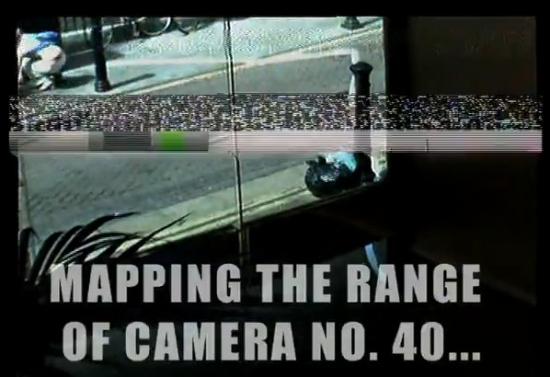
The successor to landscape painting is the “land art” of the 1960s and 1970s with its photographs of walks, mud and stones. Viewed cynically, the ‘land art’ of the 1970s is less about one man’s journey through nature than it is about cheap transport and expensive large-format cameras. It is a predecessor of the logistics art of Relationalism. The Romanticism that it shares with landscape painting is for its audience, not its commissioners. As with much art, those are two separate constituencies.
Art creates visual order and visual form for the unseen ideological order and form of the ruling class. Religious icons, jet-age land art and neoliberal Relationalism all serve this function. Critical art also depicts this ideological order, ideological form, aesthetically but to make it strange and criticise its production or content rather than to promote and naturalise it.
The Situationists treated Natopolitan 1950s Paris as a landscape to be made strange through art in order to critique the ideologies that sought to capture its population. Wandering its streets using the wrong maps was a way of challenging the authority embedded in its layout by the old regime and the new order that sought to impose its own new way of looking at things. Creating rather than using a map again re-arranges an equation, not just the equation of ‘derive’ but of the mass-media mass-politics spectacle that the Situationists were so opposed to. CCTV cameras may not seem like generators of spectacle, but their footage is used to sensationalise media reports of crime and terrorism, and their presence and visibility enforces the message that we are all part of an observed spectacle.
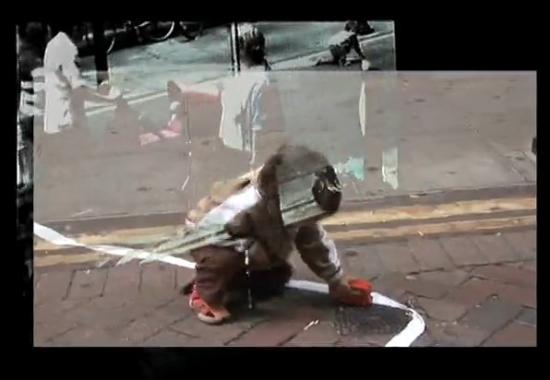
Radical land art sounds oxymoronic. But the aesthetics projected onto a landscape can be used as links to the ideology flattered by those aesthetics. And re-arranging the terms of land art can critique that ideology, or at least expose it to critique. “Mapping CCTV around Whitehall” re-arranges the equation of land art to make art of travelling to cameras in order to map the landscape they observe. This is a kind of critical, urban, reverse land art.
George Orwell’s vision of a mediatised totalitarian society from his novel “1984” is often used as a reference point for Britain’s surveillance culture. But this can obscure as much as it illuminates. Bringing out the true, novel, problems with CCTV surveillance as the default solution to the ruling class’s perception of society’s ills is an urgent and difficult task. As CCTV is a matter of the production and control of images, it is an area that art can usefully comment on. “Mapping CCTV around Whitehall” uses the status of art to represent the dark heart of surveillance ideology. Look upon its works…
http://ambienttv.net/content/?q=mappingcctv
Public screenings include ‘Films by Manu Luksch’ at Cinema2, Centre Pompidou (2009)
Betting on Shorts (2009)
http://ambienttv.net/content/www.bettingonshorts.com
NHK Japan (Japanese National Television, 2008), LIFT (2008)
Watch the video (160 sec, mp4) online at low-res.org
http://lo-res.org/~manu/MAPPINGCCTV.mp4
Or on Vimeo
http://www.vimeo.com/3802118